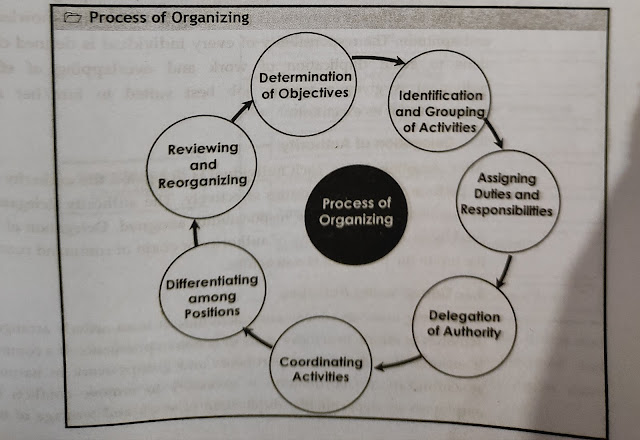Give the concept of organizing. Explain the organizing process in an organizing.
Organizing is grouping the elements of an organization in the best possible manger. It is a process of defining the essential relationships among people, tasks and activities in such a way that all the organization's resources are integrated and coordinated to accomplish its goals efficiently and effectively.
Organizing is important for an organization in a number of ways. It provides work clarity by removing duplication and overlapping of efforts. It also ensures the effective allocation of resources and enhances communication among departments or units of an organization. The following are some of the influencing definitions of organizing.
Process of Organizing
Organizing is a complex process. It demands thorough knowledge of organizational plans, policies and strategies. Organizing as a process involves the following steps:-
1. Determination of Objectives
Every organization are established for achieving certain objectives. Hence, determination of short as well as long-term objective is a major function of Jaran organization. The short-term objective should support the achievement of long-term objectives. The objectives should be specific measurable, achievable, realistic and find bound.
2. Identification and Grouping of Activities
Identification of activities: In the first step of organizing, all the y organizational activities are identified. Organizational activities vary with the nature and size of the organization. They are related to finance and accounting, production and operation, marketing and sales, human resource, and research and development.
3. Grouping of activities: In this step, the related activities are combined and grouped into units or departments and it is called departmentalization. di Similar and related activities are grouped together under a department or unit which may be further be divided into sub-departments or groups. Grouping of activities helps to secure specialization. It should be done considering human factor, the nature of activities and the needs of the agbelwand organization.
4. Assigning Duties and Responsibilities
In this step, the duties and responsibilities of discharging the activities are assigned to different individuals according to their skill, knowledge, ability and aptitude. The responsibility of every individual is defined clearly. It is done to avoid duplication of work and overlapping of effort. Each individual is given a specific job best suited to him/her and made responsible for its execution.
5. Delegation of Authority
After assigning duties, each individual is delegated the authority necessary to perform the assigned duties effectively. The authority delegated should be commensurate with the responsibility assigned. Delegation of authority establishes a clear hierarchy of authority or chain of command running from the top to the bottom of the structure.
6. Coordinating Activities
Organizing involves coordinating activities. It is an orderly arrangement of activities or efforts to achieve unity of action in pursuance of a common It ensures that different departments and groups work in harmony and synchronization. Coordination is necessary to remove conflicts between employees or departments, duplication of work and wastage of time and goal.
7. Differentiating among Positions
Organizing also involves differentiating among positions, i.e. line and staff position. A line position is the position in the direct chain of command. It is responsible for the achievement of organizational goal. On the other hand, a staff position is a supportive position, hence provides expertise, advice and support for line managers.
8. Reviewing and Reorganizing
The organizing process should be constantly reviewed and appraised so that organization structure can be modified or adjusted as per changes in the internal and external factors.




Comments
Post a Comment